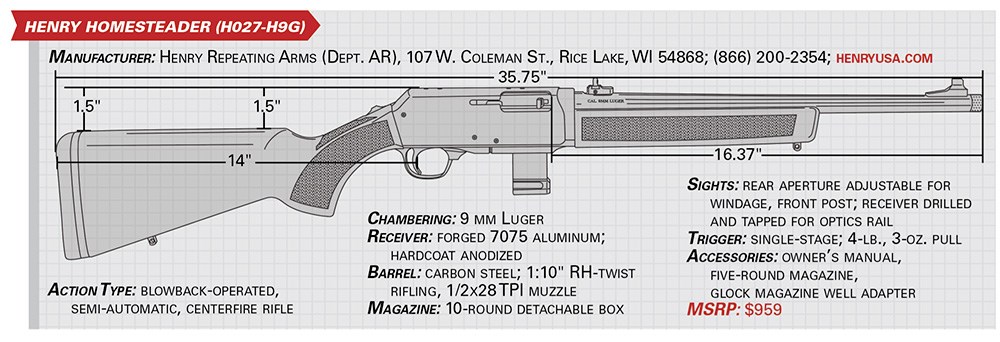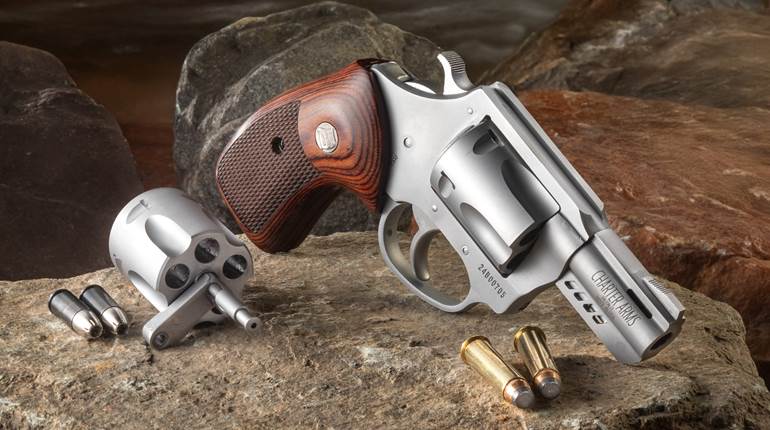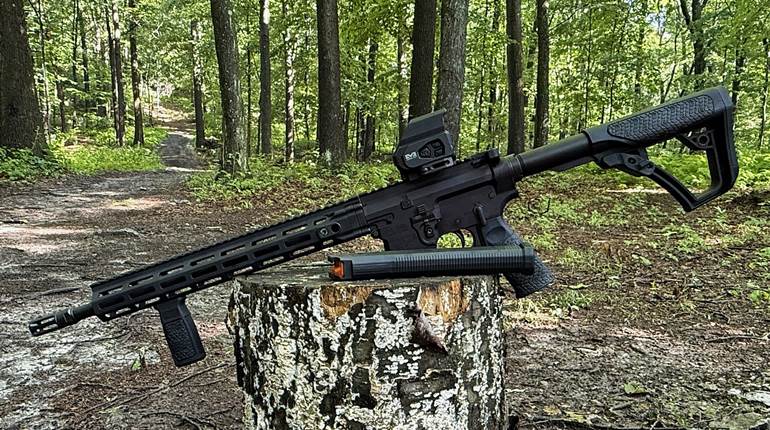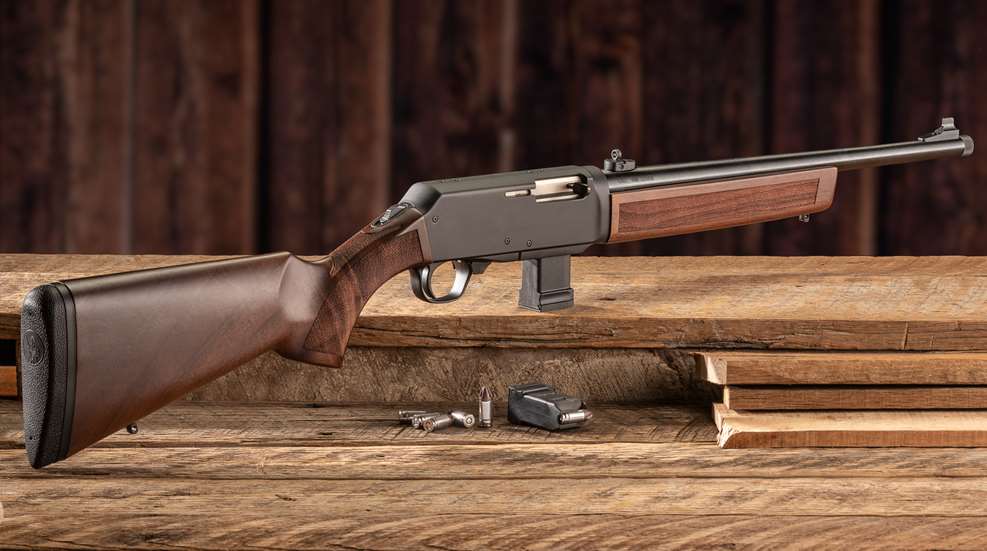
In 1996, Louis Imperato, along with his son, Anthony, launched Henry Repeating Arms in Brooklyn, N.Y. The company takes its name from Benjamin Tyler Henry, who patented his lever-action rifle in 1860, which was then manufactured by the New Haven Arms Co. from 1860 to 1866. Although today’s company has no affiliation with the first rifles to bear the Henry moniker, it has grown into a leading provider of lever guns known for both their quality and diversity. The motto, “Made in America, Or Not Made at All,” has served the new Henry well in establishing a loyal fan base. Today, Henry has more than 600 employees working in three different facilities to produce a wide-ranging catalog of options including commemorative rimfires, mare’s leg pistols, centerfire rifles and .410 bore shotguns.
Despite this growth, and the company’s popularity with lever-gun enthusiasts, the folks at Henry decided it was time to diversify their portfolio with new options that employ action types that, until now, have been outside of their wheelhouse. The first in this next generation of long guns is called the Homesteader. This semi-automatic 9 mm Luger pistol-caliber carbine (PCC), which is a popular type of long gun these days, is about as different from a lever-action .30-30 Win. as you can get. The company was careful to blend the key features of a tactical PCC with the stocks and profile of more traditional hunting rifles. The result is a handsome carbine that looks like grandpa’s gun, but with modern tactical carbine features unobtrusively tucked inside.
The Homesteader is a blowback-operated semi-automatic that pulls from a variety of design influences while using up-to-date manufacturing processes and materials. This rifle is built around a receiver that is CNC-machined from a 7075 aluminum alloy forging and treated with a matte-black Type III hardcoat anodized finish. These are the same materials and manufacturing processes commonly used to form AR-15 receiver sets. The top of the receiver is drilled and tapped to accept Weaver 63B-compatible bases, which are sold separately, for the mounting of optics. The ejection port is located to the right of the receiver, while a bolt-height slot is cut into its left side.
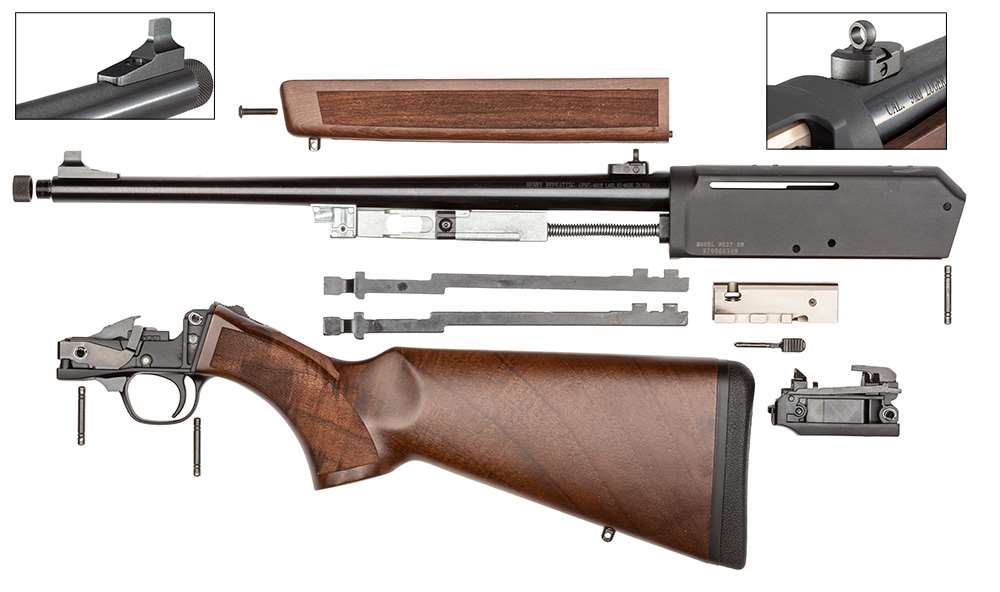
When my test Homesteader arrived, the removable and reversible bolt charging handle was stored in the box along with the magazine. The curved, grooved handle has a 0.875" extension with two holes drilled into it to align with a ball detent set into the bolt’s handle port. The handle’s design is ingenious in its simplicity; it just snaps into the bolt through either the right-side ejection port or the left-side slot with no tools or disassembly of the gun required. It is by far one of the easiest handles to reverse in the field, since the only steps required are to pull it out of the bolt and re-insert it on the other side. The only downside to the system I found is that the gripping surface of the handle is a bit too short and deeply curved for my taste. While this is by no means a deal-breaker for this gun, I do hope that the company will offer additional handle configurations, like a nice knurled barrel shape, as part of this rifle’s interchangeable component options.
Although many Henry rifles ship with semi-buckhorn iron sight systems, the Homesteader is outfitted with a removable post sight up front and an adjustable aperture sight at the rear. The company tested several sight configurations and found the aperture to be the best fit for this rifle’s intended applications. The 16.37"-long, round-profile barrel is made from a carbon steel alloy with a blued finish and traditional six-groove, 1:10" right-hand-twist rifling. The muzzle is threaded 1/2x28 TPI in order to accept a variety of popular 9 mm PCC accessories including flash hiders, compensators and sound suppressors; a knurled thread protector is provided.
The one-piece, square-profile fore-end is shaped from American walnut that has been treated with a satin polyurethane finish for added durability and moisture resistance. All three sides have panels of laser-engraved texturing for improved purchase. A sling swivel stud is fitted near the front of the fore-end, and its mate is located about 2" from the walnut shoulder stock’s recoil pad.
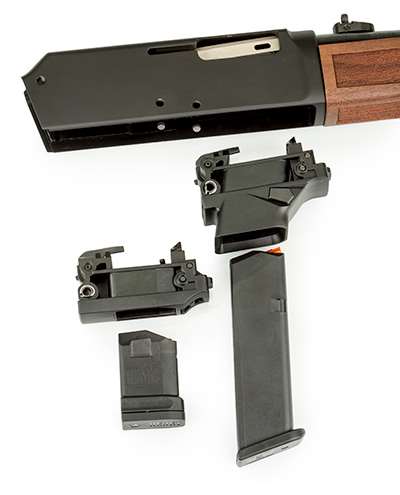
A key feature that contributes to this rifle’s flexibility is the interchangeable polymer magazine-well adapter. All Homesteaders ship with Henry’s flush-fit adapter, which is designed to accept the company’s proprietary straight-profile polymer magazines. The gun arrives with a five-round and a 10-round Henry magazine in the box. But it can also be ordered with a second adapter sized for popular pistol magazines. The Model H027-H9G used for this review arrived with a Glock adapter that accepts G26 10-round or larger magazines. The Model H027-H9S ships with a SIG/S&W-compatible adapter. These two adapters can also be purchased separately.
The trigger group is contained within an open-top aluminum housing secured inside the receiver by two of the three removable cross pins (the third pin secures the magazine-well adapter). This block also serves as the shoulder stock attachment point, and it has an integral rounded trigger guard. The curved, smooth-faced aluminum trigger is described as single-stage by the manufacturer, but the feel of the trigger I tested was a bit different than I expected. It exhibited a smooth, light, 1/8" take-up with an audible click when it met increased resistance before breaking cleanly with 4 lbs., 3 ozs., of pressure. The total trigger arc of travel is 1/4", with the reset requiring the trigger to be released back to its starting position. The trigger’s light feel and short arc make it a pleasure to work with, but this “single-stage” trigger comes very close to feeling like a two-stage trigger to me.
The Homesteader’s designers have gone out of their way to make it an ambidextrous platform. This includes the neutral shaping of the hardwood stocks, the reversible bolt handle and the configuration of the controls. The tang-mounted sliding safety selector is easily operated right- or left-handed; a bolt hold-open lever is located to either side of the front edge of the trigger guard. It should be noted that the magazine release’s location and operation changes depending on which magazine-well adapter is installed. The Henry proprietary adapter fits flush to the receiver, with a magazine-release lever located in front of the magazine well. The angled Glock magazine adapter extends an inch below the receiver with a textured magazine-release button located on the left side, which can be reversed for left-handed operation.

Like the fore-end, the sporting-style shoulder stock is made from American walnut and features the same moderate, random-pattern laser-engraved texturing on either side of the palm swell of the un-capped pistol grip. This stock is capped off with a textured, soft rubber recoil pad that gives it a length of pull (LOP) of 14". Although the Homesteader is a unique offering in several respects, it’s the warmth and familiarity of the walnut stocks that set it apart from the current crop of tactical PCCs. They gladden the eyes, feel good in the hand and provide a reassuring heft that injection-molded polymer has yet to replicate.
Breaking down the Homesteader for routine maintenance is a fairly simple process but different from other semi-automatic rifles that I’ve worked with previously. Once the magazine is removed, verify the rifle is fully unloaded. With the bolt in the closed position, use a 1/8" roll pin punch to drive out the three receiver cross pins. The owner’s manual shows the pins being driven out from the right side to the left, so I followed suit with gentle taps using a light mallet.
With the pins removed, the trigger group and shoulder stock slide straight down and out of the receiver as a single unit. The top of the trigger assembly is open so as to provide easy access to the internal components. Thus there is no need to disassemble the trigger further or to separate it from the shoulder stock for cleaning and lubrication. Just spray it down, brush it out and the trigger group is ready to go. Removing the trigger group frees the interchangeable magazine-well adapter to be removed for cleaning or traded out for a different configuration. The front edge of the well, which faces the muzzle end of the gun, has a tab that fits into a receiver slot. This means the well needs to be tipped down, from the shoulder-stock end, and then pulled down and out of the receiver.

Although this isn’t the first rifle to employ a weight-forward design, it is one of the first modern examples to do so using a wooden fore-end. The hollow fore-end is secured by a single 7/32" button-head screw located at the front end. Removing it allows the fore-end to slide forward and off of the barreled action. Inside is a weight that serves to augment the bolt’s mass and prevent bolt bounce. It is attached to an 8.25" steel guide rod that is surrounded by a round-wire coil spring. The rear of the rod passes through a port in the receiver where it is secured by a small screw. A squared-off rubber buffer protects the aluminum receiver from receiving a direct impact from the reciprocating weight as the action cycles.
To either side of the weight are two shotgun-like action bars that connect the bolt to the counterweight. Manually pressing it toward the receiver about 1/2" or so frees the action bars to be lifted away from the weight, off the bolt and out of the receiver. Removing the bolt handle allows the bolt to be lifted up and out of the receiver. The components are now ready for cleaning. Although the recoil assembly remains attached to the barrel and receiver, its components can be cleaned and oiled in place. A tip for making the re-assembly much easier is to set both action bars into the bolt assembly first and then hold them in place while pressing the weight toward the receiver. Once the weight has moved far enough, the bars snap back into place.
PCCs with blowback actions chambered in 9 mm Luger have a reputation for reliability with a wide variety of ammunition types. Nevertheless, I did my best to test the limits of the Homesteader’s performance by using as diverse a range of ammunition as I could assemble for informal and formal testing. Bullet weights ranged from 68 grains to 147 grains atop standard and +P powder charges, comprising everything from practice-grade to premium personal-protection loads. Bullet types included full metal jacket with rounded and flat noses, jacketed hollow points and even a fluted monolithic solid.
Although the proprietary Henry magazine-well adapter and magazines were functionally sound and reliable, I opted to use the majority of range time to focus on the functionality of the Glock-type adapter. Glock-compatible magazines are among the most commonly used and readily available in the world and will likely be among the most common type to find their way into this rifle. A dozen Glock factory and Magpul PMAG magazines of various capacities and generations were used to fire the various test loads. Despite all of this ammunition and magazine mixing and matching, the Homesteader did not exhibit a single malfunction, mechanical or ammunition-related, throughout the entire course of testing. Although the forward weight of the recoil assembly is noticeable when swinging the Homesteader up from the low ready position, once the carbine is shouldered, its 6-lb., 10-oz., weight balances and swings nicely.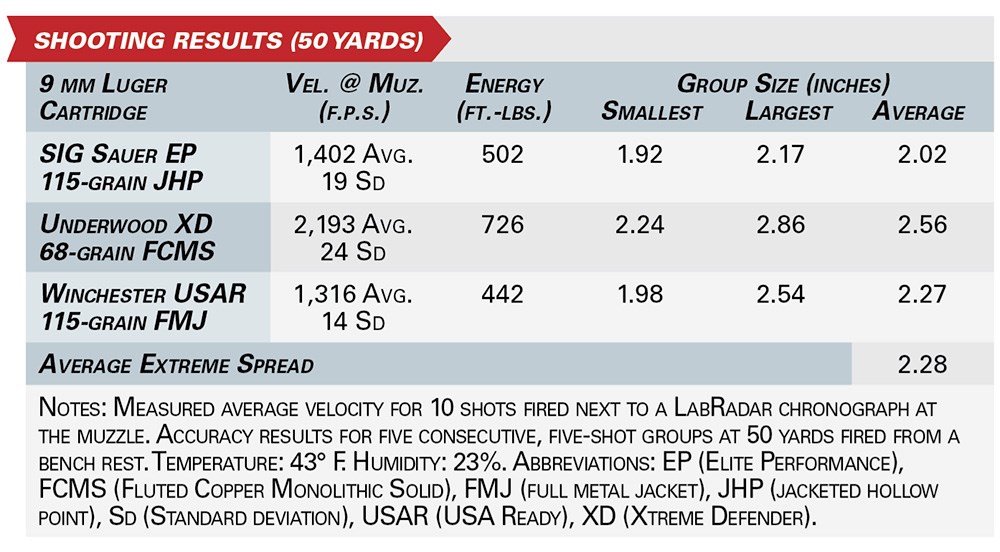
For formal five-shot, five-group accuracy testing at 50 yards, the Homesteader’s receiver was fitted with a Henry 12-slot, 5"-long Picatinny scope rail. An Athlon Optics Talos BTR Gen2 1-4X 24 mm scope, with an illuminated glass reticle, was then installed atop the gun using Athlon’s Armor Cantilever scope mount. The irony of using a tactical scope to evaluate a PCC specifically designed to look as un-tactical as possible is not lost on me. But much like the Glock magazine adapter, I suspect that many Homesteaders are going to be outfitted with magnified optics similar to this one. Group sizes at 50 yards ranged from 1.92" to 2.86" with an average extreme spread of 2.28".
Today’s PCC market is replete with a variety of models sporting plenty of blackened aluminum, M-Lok-slotted handguards and adjustable polymer stocks. And so it may seem like Henry’s choice to launch the Homesteader series with a model bedecked in old-school hardwood was out of step with current trends. But, as Steve Jobs famously stated, “People don’t know what they want until you show it to them.” Based on early customer responses to the Homesteader, it appears to be what many people want. Having tested a fair number of Henry rifles and shotguns over the years, it’s safe to say that this semi-automatic carbine lives up to the company’s reputation for well-made guns. It’s ruggedly built, and the workmanship throughout is top-notch.
The Homesteader’s stock and receiver styles are not likely to arouse concern in those regions of the country where tactical rifle features are restricted or banned. But there’s more to this carbine than just meeting local regulations. It’s handy, accurate and enjoyable to shoot while providing a look and feel that fits right in with favorite wood-stocked bolt-action rifles and pump-action shotguns. In a market awash with all-plastic-and-metal modern sporting rifles and their tactical features, it’s good to know that there is a reliable alternative that is handsome and traditional in appearance for those who want it.
